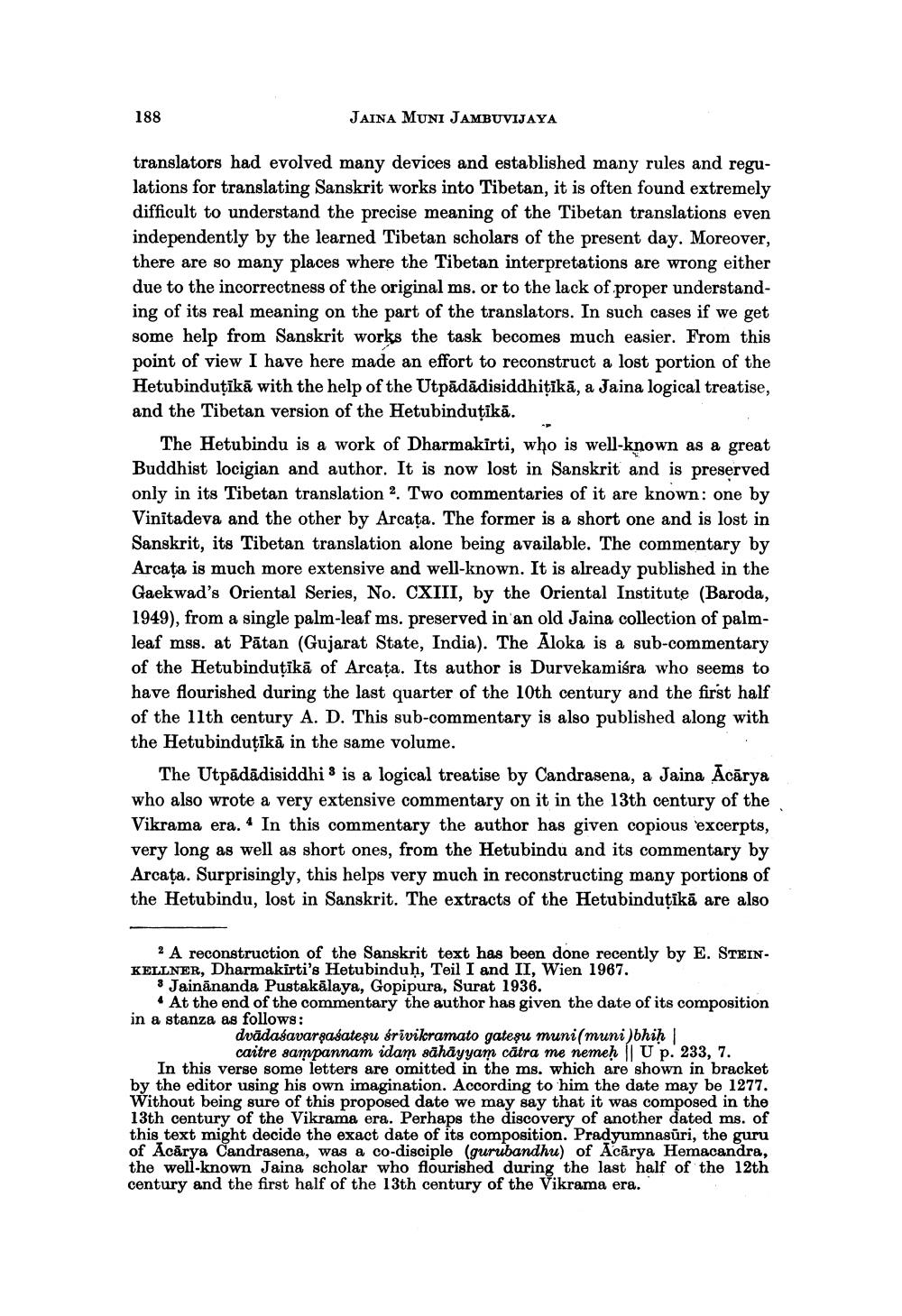Book Title: Comparative Study Of Utpadadisiddhi Tika And Hetubindu Tika Author(s): Jambuvijay Publisher: Jambuvijay View full book textPage 2
________________ 188 JAINA MUNI JAMBUVIJAYA translators had evolved many devices and established many rules and regulations for translating Sanskrit works into Tibetan, it is often found extremely difficult to understand the precise meaning of the Tibetan translations even independently by the learned Tibetan scholars of the present day. Moreover, there are so many places where the Tibetan interpretations are wrong either due to the incorrectness of the original ms. or to the lack of proper understanding of its real meaning on the part of the translators. In such cases if we get some help from Sanskrit works the task becomes much easier. From this point of view I have here made an effort to reconstruct a lost portion of the Hetubindutīkā with the help of the Utpādādisiddhitikā, a Jaina logical treatise, and the Tibetan version of the Hetubinduţikā. The Hetubindu is a work of Dharmakirti, who is well-known as a great Buddhist locigian and author. It is now lost in Sanskrit and is preserved only in its Tibetan translation 2. Two commentaries of it are known: one by Vinitadeva and the other by Arcata. The former is a short one and is lost in Sanskrit, its Tibetan translation alone being available. The commentary by Arcata is much more extensive and well-known. It is already published in the Gaekwad's Oriental Series, No. CXIII, by the Oriental Institute (Baroda, 1949), from a single palm-leaf ms. preserved in an old Jaina collection of palmleaf mss. at Pātan (Gujarat State, India). The Aloka is a sub-commentary of the Hetubindutikā of Arcata. Its author is Durvekamisra who seems to have flourished during the last quarter of the 10th century and the first half of the 11th century A. D. This sub-commentary is also published along with the Hetubinduţikā in the same volume. The Utpādādisiddhi 8 is a logical treatise by Candrasena, a Jaina Acārya who also wrote a very extensive commentary on it in the 13th century of the Vikrama era. 4 In this commentary the author has given copious 'excerpts, very long as well as short ones, from the Hetubindu and its commentary by Arcața. Surprisingly, this helps very much in reconstructing many portions of the Hetubindu, lost in Sanskrit. The extracts of the Hetubindutikā are also ? A reconstruction of the Sanskrit text has been done recently by E. STEINKELLNER, Dharmakirti's Hetubinduh, Teil I and II, Wien 1967. 3 Jainānanda Pustakālaya, Gopipura, Surat 1936. * At the end of the commentary the author has given the date of its composition in a stanza as follows: dvādaśavargasateşu srivikramato gateşu muni(muni)bhih caitre sampannam idam sāhāyyam cătra me nemeh || U p. 233, 7. In this verse some letters are omitted in the ms. which are shown in bracket by the editor using his own imagination. According to him the date may be 1277. Without being sure of this proposed date we may say that it was composed in the 13th century of the Vikrama era. Perhaps the discovery of another dated ms. of this text might decide the exact date of its composition. Pradyumnasūri, the guru of Acārya Čandrasena, was a co-disciple (gurubandhu) of Acārya Hemacandra, the well-known Jaina scholar who flourished during the last half of the 12th century and the first half of the 13th century of the Vikrama era.Page Navigation
1 2 3 4 5
